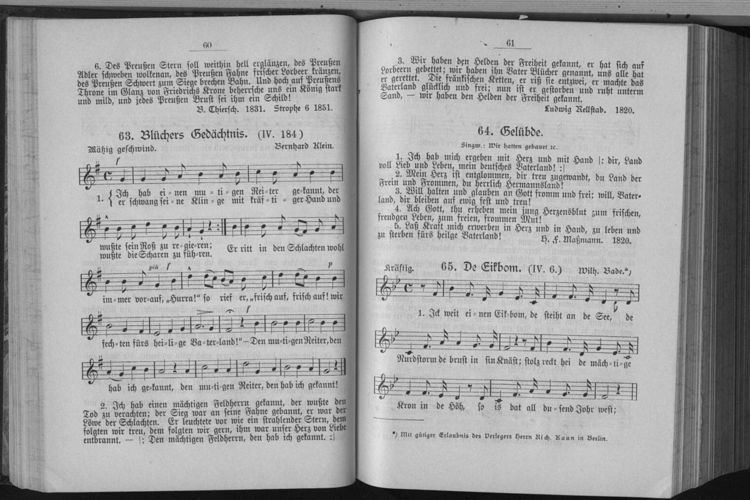 | ||
Ich hab′ mich ergeben, originally titled Gelübde ("Vow"), is a patriotic German song. The text was written in 1820 by Hans Ferdinand Maßmann. It was one of the unofficial national anthems of West Germany between 1949 and 1952 when the Deutschlandlied was officially reinstalled.
Contents
The national anthem of the Federated States of Micronesia, Patriots of Micronesia, uses the same tune, as does the Estonian song Mu Isamaa armas ("My beloved native land" by Martin Körber) which used to be Estonia's official flag song until 2009 when it was replaced by Gustav Ernesaks's Mu Isamaa on minu arm ("My homeland is my love"). The melody is quoted by Johannes Brahms in his Academic Festival Overture.
It is noteworthy that the second stanza includes the words "Land of the Free", similar to the well-known words of "The Star-Spangled Banner", written eight years earlier.
Wir hatten gebauet
The music had originally been composed for another patriotic song by August Daniel von Binzer, Wir hatten gebauet ein stattliches Haus (1819). Some sources state that in this song the colours Black, Red, and Gold are mentioned for the first time in this order which is not true. In 1817, Binzer had written a different song that begins with the words „Stoßt an! Schwarz-Rot-Gold lebe!“ (Let's toast! May Black, Red and Gold live!
The song's first performance took place on 27 January 1819 after the forced dissolution of the Urburschenschaft. Around one year later, he wrote it down in the register of the participants of the Wartburg Festival, which had taken place in 1817. There, he called the tune a "Thuringian folk song". The lyrics were published for the first time in the Kieler Commers- und Liederbuch in 1821, the tune followed in 1825.
Lyrics
The text refers to the dissolution of the Urburschenschaft ("A noble house") due to the Carlsbad decrees. During the Vormärz, censorship often replaced the colours with lines.
